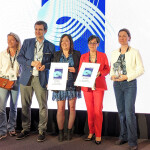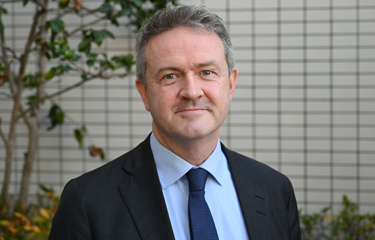Johan Kvalheim is the new director of the Norwegian Seafood Council (NSC) for Japan and South Korea. He has a master’s degree in fisheries science from the Norwegian College of Fishery Science. He previously represented the NSC in its Paris office, responsible for the French and U.K. markets from 2007 to 2013. Then he worked as general manager for MSD Animal Health in Norway for four years. He credits the development of fish vaccines by the company and its merged predecessors for improving the public image of farmed salmon. Kvalheim subsequently formed a trading company with three friends to export salmon. He rejoined NSC in December 2020. SeafoodSource spoke with him shortly after he completed his two-week quarantine period to begin his five-year assignment in Tokyo.
SeafoodSource: What are some of the first promotions you have planned as you get started in your new position?
Kvalheim: Every year we do campaigns on mackerel [and] also on salmon. At the beginning of this year, we did a continuation of the “saba-break” [Saba is mackerel in Japanese. The graphic for the ads shows a tray that uses a smartphone as one of the two pillars to support the tray.] The concept is to put the phone away and enjoy the saba. We did it quite successfully last fall and we are continuing now in February also. Then, we do activities with the retailers, a lot on salmon and also on mackerel. The salmon is more joint marketing together with the salmon exporters from Norway – and the retailers of course, while the mackerel is more where we work together with the retailers.
SeafoodSource: Japan also produces mackerel – is the country importing a lot of the mackerel in consumes?
Kvalheim: Yes. We are the largest exporter to Japan for mackerel, and for us, Japan is the most-important market. And meeting with retailers, they say the quality is really good, especially the fat and the quality in terms of how they have caught it and how they have processed it. We catch it when it is coming along our coast from September to December, and then it’s a short way from the fishing fleets to the packing stations. And the vessels are extremely technical in ensuring the quality of the fish from catching to packing. Being in Europe, I haven’t been that attached to mackerel, but coming here, seeing how passionate they are about out mackerel, it’s amazing! What we are focusing on is mostly the striped mackerel. I’m responsible not only for the Japanese, but also the Korean market, and in both markets, the mackerel is, in terms of volume, the biggest one. But in terms of value, naturally, the salmon is the biggest one.
SeafoodSource: Chile seems to have found a strong market for its salmon in Japan. How are you going to position Norwegian product against Chile?
Kvalheim: We have always been promoting Norwegian salmon as nama, untouched – the raw for sashimi, rather than the Chile kirimi [sliced], which is frozen and defrosted. For us, it’s more about the freshness – the [air-freighted] salmon. Some of the quantity is in frozen, but by far the majority of it fresh. And what we are seeing is that there is a shift going on – that we are changing from the whole salmon to fillets, and more of it is actually pre-rigor fillets. We cut the fillets immediately after harvesting, so then you send two fillets instead of the whole fish, but you have the pinbones in, because you can’t take them out before the fish is out of rigor. When it arrives in Japan, then they remove the pinbones. The texture is much better, the color is better. And the way you can actually measure it is if you put knives on the fillet, on a post-rigor fillet and a pre-rigor fillet…and measure the pressure you need to have on the knife before you crack down through the fillets, you will see that the pre-rigor fillet has a much firmer and harder texture than a post-rigor fillet.
SeafoodSource: This is all Atlantic salmon? Chile has also coho salmon and salmon-trout [rainbow trout].
Kvalheim: Yeah, and that’s one of the things that surprised me here in Japan, is this mix of all different species. This salmon market is almost like the retail market – it’s very fragmented. There’s no leader. In the rest of the world, you see that the salmon is really a category driver in the retailers – salmon is really pushing the volumes. And here, kirimi may be the category leader, but I’m not sure if there is really a category driver. In the U.S. and Europe, the retailers say salmon is really important, because it makes sure the consumer is coming back, and then we can add other species to it. But here it’s an ocean of different species. For a retailer it must be tough. You’re giving the consumer so many choices, that in the end you don’t know as a buyer which product will be tomorrow, because you haven’t focused.
SeafoodSource: There are a lot of seasonal foods in Japan. Is mackerel one of those?
Kvalheim: That surprised me about mackerel. Every time I asked [retailers], “What is the season?” And they’re like, “Season? No, we sell it throughout the year.” It’s very stable.
SeafoodSource: For the raw salmon, are you focusing on high-end sushi shops or rotary sushi chains? Do you have a certain segment you’re focusing on?
Kvalheim: Up until now, we have really worked together with the retailers. And also, we have worked with some of the sushi chains, but more on a level of just being together with them. We work together with the sushi associations in Japan. The sushi segment is more of PR, building the image. Of course, the volumes are there also, but the biggest volumes are by far in the retail. We are building the retail to make sure we have the volume, and then building the reputation and the image of the Norwegian salmon by doing links to the organizations.
SeafoodSource: Salmon and tuna are the top two sushi items in Japan – is that on your radar?
Kvalheim: It’s quite amazing how much salmon has taken off. Salmon is by far the most popular fish on the kaiten sushi in Japan according to the yearly survey conducted by Maruha Nichiro – 47.3 percent of the kaiten guests prefer the salmon versus 33.5 percent for the tuna. In our own yearly Seafood Consumer Insight that we runs in 23 countries, the trend is the same, 50.4 percent of the 23,295 respondents have salmon as first choice for sushi/sashimi. Among young women (18 to 34 years old), 55.8 percent of the respondents have salmon as their favorite sushi. In Japan, the number is 38.2 percent versus 22.2 percent for tuna. The preference for salmon is really strong among young[er] people, also in Japan.
SeafoodSource: Can fresh Norwegian salmon be eaten raw?
Kvalheim: The reason you do not have to freeze the farmed salmon for use in sushi is that the fish is fed and only eat feed that is produced in controlled and guaranteed free of [the parasite] anasakis. So, when using fresh fish for sushi, it has to be farmed.
If [Bjorn Eirik Olsen] is known for introducing salmon sushi to Japan, I want to be the one who introduces salmon portions. The first time I was in a supermarket, I was like, “Where is the most popular salmon product ever, in the world?” That is the salmon portion – and we don’t find them in Japan. And they say, “We don’t eat that. It’s too big portions.” Well, if you had asked Americans 10 years ago, they would have said exactly the same. And so you can’t do a consumer survey and check if they’re interested, because then you’ll get a “no” answer. You just need to push it and introduce it.
SeafoodSource: What are the major differences between the Japanese market and the Korean market?
Kvalheim: The Korean market is explosive in terms of growth. For mackerel, it’s 102 percent up by volume and 81 percent in value. While the sales in Japan are quite stable, [maybe] slightly down. [Exports of Norway salmon to Japan in January 2021 compared with the same month last year were 7 percent down by volume, while mackerel was up 94 percent by volume and 79 percent by value.]
Many of the importers in Japan are empty on stock for mackerel, so they need it now, the catch of 2020, to get that in to fill up their stocks again. That’s probably because there have been very good sales in retail. I think in the seafood industry, we are in a very lucky position
In Japan, salmon also fits very well with online shopping, because in online shopping the challenge with fish is that you don’t always know what you will get. Some consumers have the habit of going to the fish counter to see what they have every day. But I believe the farmed fish consumer is completely different. They don’t need to go to the fish counter to check what is available, the freshest catch or anything. They know if they buy salmon today, or if they buy it in one month, it tastes and it looks exactly the same as before.
Photo courtesy of Johan Kvalheim/Norwegian Seafood Council







